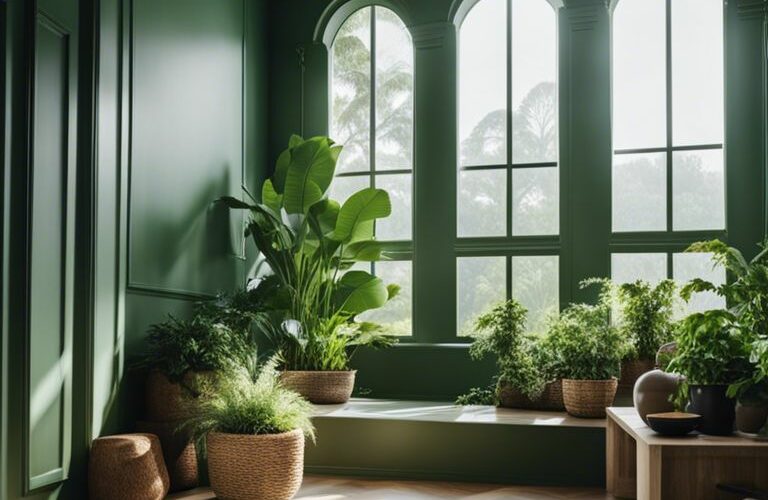Healthier living starts with the choices we make in our homes, and one significant decision that can impact our well-being is the type of paint we use. Conventional paints are laden with toxic chemicals that can harm our health and the environment. By opting for ecological paint, you can create a safer, more sustainable living space. This type of paint is made from natural ingredients, free from volatile organic compounds (VOCs), which are known to cause respiratory issues, headaches, and even contribute to air pollution. Not only does ecological paint promote better indoor air quality, but it also supports eco-friendly practices, making it a smart choice for a healthier home.
Table of Contents
Key Takeaways:
- Choose eco-friendly paints: Opt for paints labeled as low-VOC or VOC-free to reduce harmful emissions into the air.
- Promote better indoor air quality: Ecological paints help in creating a healthier living environment by minimizing toxic chemicals indoors.
- Improve overall health: By using paints made from natural ingredients, you can reduce the risk of respiratory issues, headaches, and other health problems caused by traditional paints.
- Support sustainability: Eco-friendly paints are often made from recycled materials and have minimal impact on the environment, supporting sustainability efforts.
- Enhance the aesthetic value: You can achieve beautiful and long-lasting finishes with ecological paints, ensuring a healthy and visually appealing living space.
Understanding Ecological Paint
While considering ways to create a healthier living environment, one of the key factors to focus on is the type of paint used in our homes. Ecological paint offers a sustainable and non-toxic alternative to traditional paints, making it a popular choice for environmentally conscious consumers. Understanding the characteristics and benefits of ecological paint is crucial in making informed decisions for a greener lifestyle.
Definition and Key Characteristics
Definition: Ecological paint, also known as eco-friendly or green paint, is made from natural raw materials such as plant oils, minerals, and water. These paints are free from harmful chemicals like volatile organic compounds (VOCs) and heavy metals, making them safer for both the environment and human health.
Eco paints are available in a variety of finishes, including matte, eggshell, and gloss, and come in a wide range of colors, providing the same aesthetic options as traditional paints. Additionally, ecological paints are often biodegradable, reducing their impact on the environment even after use.
Comparison with Traditional Paints
Traditional Paints vs. Ecological Paints
| Traditional Paints | Ecological Paints |
| Contain VOCs and toxic chemicals | Free from VOCs and toxic chemicals |
| Can release harmful fumes into the air | Do not emit harmful fumes |
| Longer drying time | Quick drying time |
| Can contribute to indoor air pollution | Help improve indoor air quality |
When comparing traditional paints with ecological paints, it becomes evident that the latter offers a safer and more sustainable option for painting interiors. The absence of VOCs and toxic chemicals in ecological paints not only benefits the health of occupants but also reduces the negative impact on the environment.
Benefits of Ecological Paint
Health Advantages for Occupants
Even in our homes, the air we breathe can have a significant impact on our health. Traditional paints release Volatile Organic Compounds (VOCs) into the air, which can lead to respiratory issues, headaches, and dizziness for occupants. However, ecological paints are made from natural ingredients such as plant oils, clay, and minerals, making them low in VOCs and non-toxic for indoor air quality. For those with respiratory conditions or allergies, this can greatly improve their quality of life.
Moreover, ecological paint is odorless and breathable, creating a more comfortable living environment. This can be particularly beneficial for individuals who are sensitive to strong odors or have asthma. By choosing ecological paint, homeowners can ensure that their indoor environment promotes health and well-being for themselves and their families.
Environmental Impact
Health and environmental sustainability go hand in hand when it comes to ecological paint. These paints are biodegradable and do not emit harmful chemicals into the environment. Traditional paints contribute to air pollution and harm ecosystems by releasing toxins into the air and water sources. By using ecological paint, homeowners can reduce their carbon footprint and contribute to a healthier planet for future generations.
The production of ecological paint entails reduced energy consumption and less waste generation compared to conventional paint manufacturing processes. This makes ecological paint a sustainable choice that aligns with environmentally conscious practices. Making the switch to ecological paint is a small but impactful step towards creating a more ecologically responsible living environment.
Application of Ecological Paint
Preparing Your Living Space for Painting
To ensure a successful application of ecological paint in your living space, proper preparation is key. Start by clearing the area of furniture and covering floors and fixtures to protect them from any potential drips or spills. Next, fill and sand any cracks or holes in the walls to create a smooth surface for the paint to adhere to. Ensure that the walls are clean and free of dust, dirt, and grease by wiping them down with a damp cloth.
Best Practices for Applying Ecological Paint
To achieve the best results when applying ecological paint, begin by using high-quality brushes and rollers that are designed for use with eco-friendly paints. Apply the paint evenly and in thin coats, allowing each layer to dry completely before applying the next. Avoid painting in extreme temperatures or high humidity, as this can affect the paint’s ability to dry properly and result in a subpar finish.
This will help to minimize fumes and ensure a healthier environment for you and your family. Additionally, be sure to follow the manufacturer’s instructions for the specific ecological paint you are using to achieve the best results.
Maintenance and Durability
Not only is ecological paint good for the environment, but it also offers several practical benefits when it comes to maintenance and durability.
Caring for Ecologically Painted Surfaces
Maintenance: Proper care of ecologically painted surfaces is vital to maintain their longevity. To clean these surfaces, use gentle cleaning solutions and avoid harsh chemicals that can damage the paint. Regular dusting and wiping with a soft cloth can help prevent dirt buildup and extend the life of the paint.
Durability: Ecological paint is designed to be durable and long-lasting, providing excellent protection for your walls. With proper maintenance, these painted surfaces can withstand everyday wear and tear, making them a sustainable choice for a healthier living environment.
Long-Term Benefits and Lifecycle
An understanding of the long-term benefits and lifecycle of ecological paint can help you make informed decisions when choosing paint for your home. Ecological paint is known for its high quality and longevity, making it a cost-effective choice in the long run.
Painted surfaces with ecological paint have been shown to have lower levels of volatile organic compounds (VOCs), which can have harmful health effects. By choosing ecological paint, you are not only reducing your carbon footprint but also creating a safer and healthier environment for you and your family.
Conclusion
Considering all points discussed, it is evident that using ecological paint can significantly contribute to creating a healthier living environment. With its low volatile organic compounds (VOCs) content and natural ingredients, ecological paint helps reduce indoor air pollution, making it safer for both inhabitants and the environment. By choosing ecological paint for your home, you can improve indoor air quality, reduce health risks, and support sustainable practices in the paint industry. Making the switch to ecological paint is a simple yet impactful step towards creating a more sustainable and healthy living space for you and your loved ones.
FAQ
Q: What is ecological paint?
A: Ecological paint, also known as eco-friendly or green paint, is a type of paint that is made from natural and non-toxic ingredients. These paints are better for the environment and for your health compared to traditional paint options.
Q: Why should I choose ecological paint for my living environment?
A: Choosing ecological paint for your living environment can help reduce indoor air pollution, minimize your exposure to harmful chemicals, and support sustainable practices in the paint industry. It is a healthier and more environmentally friendly choice.
Q: How does ecological paint contribute to a healthier living environment?
A: Ecological paint contributes to a healthier living environment by emitting fewer volatile organic compounds (VOCs) and toxic fumes compared to conventional paints. This helps improve indoor air quality and reduces health risks associated with paint-related toxins.
Q: Are there different types of ecological paint available in the market?
A: Yes, there are different types of ecological paint available, such as natural paints made from ingredients like clay, lime, or plant-based oils, and low-VOC paints that contain minimal levels of harmful chemicals. These options provide a variety of choices for eco-conscious consumers.
Q: How can I ensure the best results when using ecological paint in my living space?
A: To ensure the best results when using ecological paint, make sure to properly prepare the surface, follow the manufacturer’s instructions for application, and allow for adequate ventilation during and after painting. Choosing high-quality ecological paint and tools will also help achieve a professional finish.

Our contributing author is a passionate advocate for eco-friendly living and sustainability. With a background in eco-life, they are dedicated to inspiring and empowering individuals to adopt environmentally conscious lifestyles. Through insightful articles, they share practical tips, innovative solutions, and thought-provoking perspectives to promote a greener, more sustainable world. Join them on the journey towards eco-smart living and discover how small choices can make a big impact. 🌱









